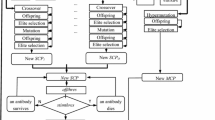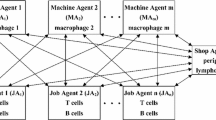Abstract
The role of human resources in manufacturing systems is very significant, and without efficient human resources we encounter high-price products with low quality. To improve the efficiency of human resources, we need to provide an optimal working schedule for each worker in production period. In this paper, we proposed a mixed-integer nonlinear model to find the best working schedule based on product quality cost and workers reliability. In this model, if the worker’s exhaustion level reaches a specific limit, the worker can rest to increase his reliability level and an accommodator should work instead of him. Since the proposed model is NP-hard, we used an artificial immune system to provide the best working schedule. The results indicate that this model can provide efficient and effective human resources schedule in manufacturing systems.



Similar content being viewed by others
References
Adamyan A, He D (2002) Analysis of sequential failures for assessment of reliability and safety of manufacturing systems. Reliab Eng Syst Safe 76:227–236
Allaouia H, Lamourib S, Artibab A, Aghezzaf E (2008) Simultaneously scheduling n jobs and the preventive maintenance on the two-machine flow shop to minimize the makespan. Int J Prod Econ 112:161–167
Brombacher AC, Sander PC, Sonnemans PJM, Rouvroye JL (2005) Managing product reliability in business processes ‘‘under pressure’’. Reliab Eng Syst Safe 88:137–146
Chen WJ (2006) Minimizing total flow time in the single-machine scheduling problem with periodic maintenance. J Oper Res Soc 57:410–415
Chen Y, Jin J (2005) Quality–reliability chain modeling for system–reliability analysis of complex manufacturing processes. IEEE Trans Reliab 54:475–488
Gendreau M, Potvin JY (2010) Handbook of meta heuristics. Springer, New York
Guan X, He J, Jha R, Liu Y (2012) An efficient analytical Bayesian method for reliability and system response updating based on Laplace and inverse first- order reliability computations. Reliab Eng Syst Safe 97:1–13
Ishibuchi H, Murata T (1998) A multi-objective genetic local search algorithm and its application to flowshop scheduling. IEEE Trans System, Man Cybern 28(3):392–403
Jerne NK (1974) Towards a network theory of the immune system. Ann Immunol 125:373–389
Ji M, He Y, Cheng TCE (2007) Single-machine scheduling with periodic maintenance to minimize makespan. Comput Oper Res 34:1764–1770
Jin J, Chen Y (2001) Quality reliability information integration for design evaluation of fixture system reliability. Qual Reliab Eng Int 17:355–372
Karim MR, Suzuki K (2005) Analysis of warranty claim data: a literature review. Inte J Qual Reliab Manag 22:667–686
Keuls M (1952) The use of the Studentized range in connection with an analysis of variance. Euphytica 1:112–122
Liao CJ, Chen WJ (2003) Single-machine scheduling with periodic maintenance and nonresumable jobs. Comput Oper Res 30:1335–1347
Marseguerra M, Zio E (2000) Optimizing maintenance and repair policies via a combination of genetic algorithms and Monte Carlo simulation. Reliab Eng Syst Safe 68(1):69–83
O’Connor PDT (2004) Variation in reliability and quality. Qual Reliab Eng Int 20:807–821
Regattieri A, Manzini R, Battini D (2010) Estimating reliability characteristics in the presence of censored data: a case study in a light commercial vehicle manufacturing system. Reliab Eng Syst Safe 95:1093–1102
Sander PC, Brombacher AC (2000) MIR: the use of reliability information flows as a maturity index for quality management. Qual Reliab Eng Int 15:439–447
Savsar M (2000) Reliability analysis of a flexible manufacturing cell. Reliab Eng Syst Safe 67:147–152
Sheu S, Jhang J (1996) A generalized group maintenance policy. Eur J Oper Res 96(2):232–247
Thomas L (1986) A survey of maintenance and replacement models for maintainability and reliability of multi-item systems. Reliab Eng 16(4):297–309
Tiwari MK, Raghavendra N, Agrawal Sh, Goyal SK (2010) A hybrid Taguchi-immune approach to optimize an integrated supply chain design problem with multiple shipping. Eur J Oper Res 203:95–106
Weber P, Jouffe L (2006) Complex system reliability modeling with dynamic object oriented Bayesian networks (DOOBN). Reliab Eng Syst Safe 91:149–162
Xu DH, Sun KB, Li HX (2008) Parallel machine scheduling with almost periodic maintenance and non-preemptive jobs to minimize makespan. Comput Oper Res 35:1344–1349
Author information
Authors and Affiliations
Corresponding author
Rights and permissions
About this article
Cite this article
Jamshidi, R., Seyyed Esfahani, M.M. Human resources scheduling to improve the product quality according to exhaustion limit. TOP 22, 1028–1041 (2014). https://doi.org/10.1007/s11750-013-0310-z
Received:
Accepted:
Published:
Issue Date:
DOI: https://doi.org/10.1007/s11750-013-0310-z




